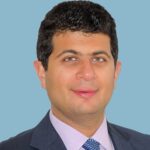
People who suffer from cubital tunnel syndrome experience pain similar to the sharp ache that happens when the elbow’s “funny bone” gets whacked. That not so funny electric tingling sensation followed by nerve pain, is in fact a reaction of the ulnar nerve, a nerve that crosses the elbow and extends all the way from the side of the neck to the fingertips. Cubital tunnel syndrome is a condition of the ulnar nerve where it becomes inflamed, swollen, and irritated. Symptoms can be experienced as sensations similar to the ouch of funny bone pain.
Symptoms of ulnar nerve neuropathy may include:
- A feeling of weakness in the hand
- Tingling in the fourth and fifth fingers, tingling in the palm
- Sensitivity to cold
- The elbow joint feels sore or tender to the touch
Ulnar nerve conditions can cause pain, numbness and tingling in the forearm and the fourth and fifth fingers. In severe cases, in addition to weakness in the hand it can also cause loss of muscle mass. In most cases, nonsurgical treatments can be helpful such as making changes in activities and applying bracing. If these treatments do not improve symptoms, or if the nerve compression is causing muscle weakness or damage in the hand, then surgery may be recommended.
Potential causes
Some situations that can cause pressure on the nerve at the elbow include;
- Repeated stretching can irritate the nerve, so when the elbow is bent for long intervals or overusing or repeatedly bending the elbow, can cause painful symptoms.
- In some cases, the ulnar nerve simply slides out from behind the medial epicondyle when the elbow is bent, and this constant sliding back and forth may result in an irritated nerve.
- Putting pressure on or leaning on the elbow for long periods of time can irritate on the nerve.
- Fluid buildup in the elbow can cause swelling that may compress the nerve.
- Trauma or a forceful blow to the inside of the elbow can cause pain setting off a sensation of electric shock and numbness in the little and ring fingers.
Symptoms can usually be relieved at home, but when symptoms interfere with normal activities or last more than a few weeks, it may be time to make an appointment with your doctor.
Nonsurgical treatments may include nonsteroidal anti-inflammatory drugs, using bracing or splints, and physical therapy such as nerve gliding exercises. When all else fails, surgery may be the next step. Surgery is an outpatient procedure and depending on the specific patient and condition could encompass cubital tunnel release (ligament roof of the cubital tunnel is cut and divided to increases the size of the tunnel and decreases pressure on the nerve).
Ulnar nerve anterior transposition is another option where the nerve is moved from its place behind the medial epicondyle to the front of it to prevent it from getting caught on the bony ridge and stretching when the elbow bends. Medial epicondylectomy is a technique that helps to prevent the nerve from getting caught on the boney ridge and stretching when the elbow is bent.
If the nerve has been severely compressed or when muscle wasting is present, the nerve may be damaged to the point that some symptoms persist, even after the surgery. Also, nerves heal very slowly, so it may take a long time to know how well the procedure went after surgery.
Article source: AAOS OrthoInfo
SRO Shoulder and Elbow Care Center
As one of the top programs in the North Bay for shoulder care Santa Rosa Orthopaedic’s Shoulder and Elbow programs provides highly specialized care to those experiencing arm pain. Our patients benefit from the expertise and skill of specialists who perform countless procedures each year while continually pioneering advances in repair and replacement.

Dr. Neema Pourtaheri is a board certified orthopaedic surgeon with subspecialty interest and fellowship training in shoulder and elbow surgery. With his advanced training Dr. Pourtaheri is able to offer patients the latest advancements in shoulder and elbow care. He also practices general orthopaedics including arthroscopy, fracture care, joint replacement, and minimally invasive procedures. He also performs PRP and stem cell injections. Learn more…

